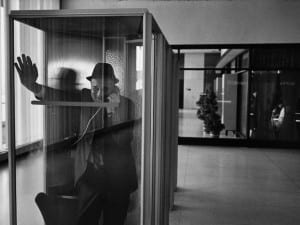The story of Australian art is deeply entwined with the fecund, often dangerous and forever mysterious indigenous landscape. Spanning nearly 250 years of fascination with their alluring and demanding land mass, Australia, hosted by the Royal Academy of Arts and Patroned by the Prince of Wales, flaunts its lively works of art, including paintings, drawings, photographs, watercolours and multimedia, for the first time to an international audience as a comprehensive whole.
HRH The Prince of Wales calls the exhibition “an extraordinary achievement” and in praising the scope of its affect, recalls his first stay in Australia’s exotic landscape, where he was “deeply struck by the distinctive colours and light of [Australian poet Dorothea] Mackellar’s ‘sunburnt country’”.
This robustly inclusive exhibition features more than 200 art works from Frederick McCubbin’s 1904 painting, The Pioneer, to Shaun Gladwell’s 2007 video art, Approach to Mundi Mundi, stopping by the best of Australian aboriginal art, and such memorable works as Sydney Sun, John Olsen’s iconic 1965 three-panel painting, which in all its orgiastic expression of fertility and regeneration in Australian nature, will be exalted as a ceiling panel.
We spoke to Olsen on the cusp of Australia, which opened at the Royal Academy of Arts in London on September 21 and runs until December 8.
A: How exciting to be throwing the first comprehensive Australian landscape-inspired exhibition in Britain – what do you think this show will reveal to the Brits about the Australians?
JO: Yes, it is a really exciting, important show. It features the best of aboriginal art, the best of 19th century art and the best of art right through to today. It is the story of our Australian truth. The show will reveal our truth.
Europeans try to understand landscape by taming it. Those metrics don’t fit in Oz, where the landscape is aloof, as if it has it’s own character, from the populated edges to the dead heart. These scenes of strangeness and vastness, where there exists all kinds of weird marsupials, are not rolling and pleasing to the eye in the way that landscape painting tradition is accustomed to. The Australian landscape is dry and ancient, it exposes its mirrors and muscles – it’s rough and tough. I often think how fortunate we are to be able to portray things that have never appeared before in art. In Australia we have learned to do the opposite of taming, and allowed ourselves to be untamed by nature. Our truth is a truth of feeling. It’s a deep sense of ‘We feel okay in this landscape’.
A: That’s interesting. Because of its breadth, the work in this show spans the evolution from tamer British colonials to untamed citizens of a beguiling and hostile place, then. Do you feel that the landscape itself has had something to do with the untaming process?
JO: Yes, I do. There is always a transfer of spirit between a place and its people. In Australia, there is the scorching sunlight and the immense blue sky and the raw red vastness of land. The way to look at the Australian landscape is from slightly above ground. The aboriginals have always known this and they paint from the air – Sidney Nolan discovered this too when he hitched a ride to Alice Springs on a mail plane in 1948 and began to record Australian nature from above. When his work was first shown in Britain they thought his were paintings of the moon.
A: Do you see a similarity between Australian aboriginal art and the art of the untamed settlers of Australia?
JO: Traditional aboriginal art looks from the aerial perspective at Dreamtime roadmaps and at x-ray visions of animals; crocodiles, fish. It is not interested in light, there are no observations of trees, brown curving marks are occasional rivers – their work is beautiful, archetypal, it has been about tribal reinforcement without emphasis on individual style or preference. It’s very Jungian.
We, the settlers, have more ego. There is an ‘I’ in the work and a contemplation about where the ‘I’ fits within this rough landscape. In its approach it’s very expressionistic: I am here, I feel, I put it down.
A: In your own work, you’re right at the centre of the landscape, it feels as if you even are the landscape.
JO: You know, I’ve always sought empathy with the landscape, that feeling of being the bloodstream itself; of experiencing a total involvement with what I am looking at and somehow letting that percolate to my centre. It is very instinctual.
A: You achieve this sensation so viscerally in Sydney Sun, which will be hung as a stand-in sun ceiling in the Australia exhibit. What is the story behind this painting?
JO: I originally painted it as a ceiling in reflection of the sun, and it was bought by Rupert Murdoch for his ceiling in the gym and pool room of his California home. When his first marriage broke up he moved to New York City and Sydney Sun returned to Australia, and was acquired by the National Gallery. It turned out to be very popular. I think that’s because Australians are born under the sun and because of that light, we see the world differently. Life is so alive under the Australian sun. We are bon ami in a milieu that is teeming with energy.
A: You may be thought of as the Dionysus of Australian art.
JO: Oh yes, I’ve been very Dionysian! Not to take away from Apollo, reason and recollection are important in life and art too. But I would never put them first; it is a mistake to put the mind first. I would say that instinct is vital, it’s the drive; it’s what you feel is the truth from an immediate experience of that truth.
A: I wonder if this art in celebration of truthful instinct will assault British sensibilities.
JO: Oh yes, I hope it knocks their socks off!
Caia Hagel
Australia, 21 September until 8 December, Royal Academy of Arts, Burlington House, Piccadilly, London, W1J 0BD. www.royalacademy.org.uk
Credit: John Olsen’s, Sydney Sun, courtesy of Royal Academy and the artist.





